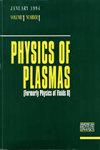非均质磁场中上混合振荡时空演变的片状模型描述
IF 2.2
3区 物理与天体物理
Q3 PHYSICS, FLUIDS & PLASMAS
引用次数: 0
摘要
利用道森片模型[J. Dawson, Phys. Fluids 5, 445-459 (1962)]对存在不均匀磁场的冷均质等离子体中大振幅上混振荡的时空演变进行了分析和数值研究。研究发现,磁场的不均匀性会导致上混频获得空间依赖性,从而导致相位混合,并随后在任意低振幅下打破上混振荡。这一结果与均匀磁场中通常的上混频振荡形成了鲜明对比,在上混频振荡中,当振幅超过某个临界值时,振荡会在一小部分周期内断裂[R. C. Davidson, Methods of Mechanics, 2000, pp.C. Davidson, Methods in Nonlinear Plasma Theory (Academic, New York, 1972)]。我们的微扰计算表明,相混(破波)时间与磁场不均匀性振幅(Δ)和外加密度扰动振幅(δ)成反比,并直接与磁场不均匀性尺度长度与外加密度扰动尺度长度之比[(α/kL)-1]成正比,即 ωpeτmix∼(1+β2)3/2kL/(β2δΔα) 、其中,β 是电子回旋频率与电子等离子体频率之比。使用基于道森片模型[J. Dawson,Phys. Fluids 5, 445-459 (1962)]的 1-1/2 D 代码模拟测量的进一步相混时间与上述比例关系十分吻合。这一结果可能与存在横向不均匀磁场的等离子体粒子加速实验有关。本文章由计算机程序翻译,如有差异,请以英文原文为准。
Sheet model description of spatiotemporal evolution of upper-hybrid oscillations in an inhomogeneous magnetic field
Spatiotemporal evolution of large amplitude upper-hybrid oscillations in a cold homogeneous plasma in the presence of an inhomogeneous magnetic field is studied analytically and numerically using the Dawson sheet model [J. Dawson, Phys. Fluids 5, 445–459 (1962)]. It is observed that the inhomogeneity in magnetic field, which causes the upper-hybrid frequency to acquire a spatial dependence, results in phase mixing and subsequent breaking of the upper-hybrid oscillations at arbitrarily low amplitudes. This result is in sharp contrast to the usual upper-hybrid oscillations in a homogeneous magnetic field, where the oscillations break within a fraction of a period when the amplitude exceeds a certain critical value [R. C. Davidson, Methods in Nonlinear Plasma Theory (Academic, New York, 1972)]. Our perturbative calculations show that the phase mixing (wave breaking) time scales inversely with the amplitude of magnetic field inhomogeneity (Δ) and amplitude of imposed density perturbation (δ) and scales directly with the ratio of magnetic field inhomogeneity scale length to imposed density perturbation scale length [(α/kL)−1] as ωpeτmix∼(1+β2)3/2kL/(β2δΔα), where β is the ratio of electron cyclotron frequency to electron plasma frequency. Further phase mixing time measured in simulations, performed using a 1–1/2 D code based on the Dawson sheet model [J. Dawson, Phys. Fluids 5, 445–459 (1962)], shows good agreement with the above-mentioned scaling. This result may be of relevance to plasma based particle acceleration experiments in the presence of a transverse inhomogeneous magnetic field.
求助全文
通过发布文献求助,成功后即可免费获取论文全文。
去求助
来源期刊

Physics of Plasmas
物理-物理:流体与等离子体
CiteScore
4.10
自引率
22.70%
发文量
653
审稿时长
2.5 months
期刊介绍:
Physics of Plasmas (PoP), published by AIP Publishing in cooperation with the APS Division of Plasma Physics, is committed to the publication of original research in all areas of experimental and theoretical plasma physics. PoP publishes comprehensive and in-depth review manuscripts covering important areas of study and Special Topics highlighting new and cutting-edge developments in plasma physics. Every year a special issue publishes the invited and review papers from the most recent meeting of the APS Division of Plasma Physics. PoP covers a broad range of important research in this dynamic field, including:
-Basic plasma phenomena, waves, instabilities
-Nonlinear phenomena, turbulence, transport
-Magnetically confined plasmas, heating, confinement
-Inertially confined plasmas, high-energy density plasma science, warm dense matter
-Ionospheric, solar-system, and astrophysical plasmas
-Lasers, particle beams, accelerators, radiation generation
-Radiation emission, absorption, and transport
-Low-temperature plasmas, plasma applications, plasma sources, sheaths
-Dusty plasmas
 求助内容:
求助内容: 应助结果提醒方式:
应助结果提醒方式:


